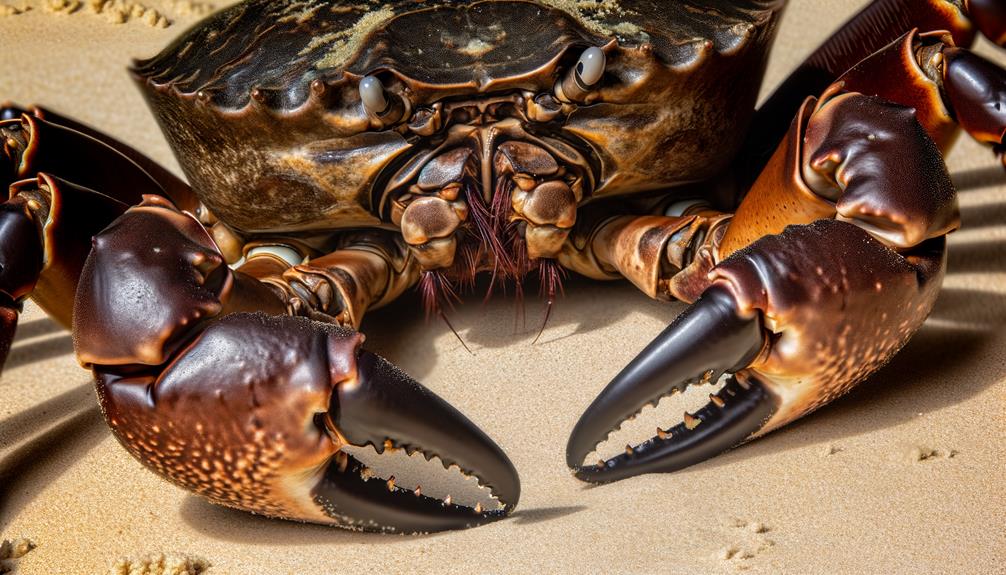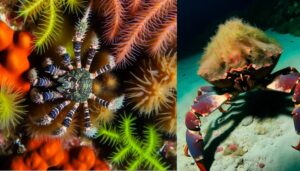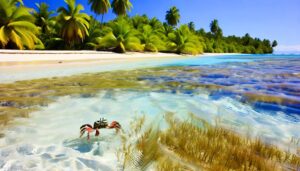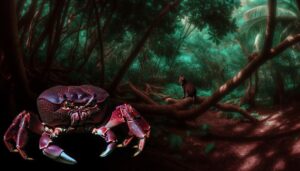Do Coconut Crabs Have Teeth and How Do They Feed?
Coconut crabs, or Birgus latro, don't have gold teeth. Instead, they possess robust, chitin-based claws capable of exerting up to 3300 newtons of force, essential for cracking open coconuts.
Their formidable exoskeletons, composed of chitin and calcium carbonate, provide superior protection and structural support. These crabs rely on their muscular legs for effective terrestrial movement and specialized gills for breathing air.
Myths often exaggerate their features, but scientific studies reveal their true adaptations that enable them to thrive in coastal environments. Understanding these evolutionary traits sheds light on their ecological success and complex behaviors.

Key Takeaways
- Coconut crabs do not have gold teeth; their claws are made of chitin.
- The powerful claws are used to crack open coconuts and for defense.
- Claws contain sensory organs to detect food, not gold teeth.
- The misconception likely arises from the crab's formidable appearance.
- Scientific studies confirm their claws' composition includes chitin and calcium carbonate, not gold.
What Are Coconut Crabs?
Coconut crabs, also known as Birgus latro, are the largest terrestrial arthropods on Earth, capable of growing up to a meter in leg span and weighing up to 4.1 kilograms. They belong to the family Coenobitidae and are closely related to hermit crabs.
Unlike their marine relatives, coconut crabs have adapted to a fully terrestrial lifestyle, only returning to the sea to spawn. Their name derives from their ability to crack open coconuts with their powerful claws, a feat that demonstrates their remarkable strength.
These crabs exhibit a unique set of behaviors and ecological roles, primarily inhabiting coastal forests and rocky shorelines in the Indo-Pacific region. Their diet is omnivorous, including fruits, carrion, and smaller animals.
Physical Characteristics
Birgus latro exhibits a formidable array of physical traits that underscore its adaptation to a terrestrial environment, starting with its robust exoskeleton that provides both protection and support. This exoskeleton allows the crab to withstand significant physical impacts, which is essential for its survival on land.
Its powerful claws, capable of exerting tremendous force, are instrumental in cracking open coconuts and defending against predators. The crab's large, muscular legs facilitate efficient terrestrial locomotion, enabling it to navigate various terrains. Additionally, specialized gills adapted for breathing air allow it to thrive outside of water.
Its impressive size, often reaching up to 4 kg, further exemplifies its evolutionary success in exploiting terrestrial niches. These physical characteristics collectively highlight Birgus latro's remarkable terrestrial adaptation.
The Gold Teeth Myth
The notion of coconut crabs possessing gold teeth, though intriguing, is a myth that has no basis in scientific reality. Coconut crabs, known scientifically as Birgus latro, don't possess teeth in the conventional sense. Instead, they've powerful pincers used for breaking open coconuts, their primary food source.
The myth likely stems from the crab's strong, shiny mandibles, which can appear metallic under certain lighting conditions. Detailed anatomical studies reveal that these structures are composed of chitin, a natural polymer, rather than any metallic substance.
Additionally, no biological mechanism exists within coconut crabs to deposit gold or other metals into their exoskeletal components. This debunks the gold teeth myth, reinforcing the need for accurate scientific communication.
Crab Exoskeletons
Crab exoskeletons, mainly composed of chitin and calcium carbonate, provide a sturdy and flexible armor that supports and protects their bodies. This exoskeleton affords crabs both structural integrity and defense against predators.
Chitin, a polymer, offers flexibility, while calcium carbonate imparts hardness, creating a balance between rigidity and movement. The exoskeleton also plays a pivotal role in muscle attachment, facilitating locomotion and other essential activities.
Periodically, crabs undergo molting, shedding their old exoskeleton to grow a new, larger one. During this vulnerable phase, they seek refuge to avoid predation. Understanding the composition and function of crab exoskeletons reveals the intricate adaptations that enable these creatures to thrive in diverse environments, from terrestrial to marine ecosystems.
Claws and Feeding
Possessing remarkably powerful claws, coconut crabs utilize these formidable appendages to crack open hard-shelled coconuts and access the nutritious contents inside. Their claws generate a force up to 3300 newtons, allowing them to exert immense pressure on their prey. This aptitude is essential for their diet, which includes fruits, nuts, and even small animals.
The crabs' pincers are also equipped with sensory organs, enhancing their ability to detect food. These claws function as both tools and weapons, providing defense against predators. Additionally, coconut crabs exhibit a unique feeding behavior: they meticulously pick apart their meals, using their smaller appendages to consume food pieces efficiently.
This combination of strength and dexterity makes them exceptional feeders in their ecological niche.
Natural Habitat
Coconut crabs primarily inhabit coastal regions, favoring areas with abundant vegetation and sandy soil. Their physiological adaptations allow them to thrive in humid, tropical climates, where they can efficiently regulate their moisture levels.
These crabs construct intricate burrows for shelter, providing protection from predators and extreme weather conditions.
Coastal Region Preferences
Many coconut crabs exhibit a strong preference for coastal areas, where they thrive in environments abundant with rocky crevices and dense vegetation. These areas provide important resources, such as food and shelter, necessary for their survival.
Coastal regions offer a diverse diet, including fruits, nuts, and carrion, which supports the crabs' omnivorous feeding habits. The rocky crevices serve as secure hideouts, protecting them from predators and harsh environmental conditions. Dense vegetation not only offers additional food sources but also maintains humidity levels, crucial for their respiratory function.
Coastal habitats also facilitate their breeding activities, as females release their eggs into the ocean. Therefore, these environments are integral to the coconut crabs' lifecycle and overall well-being.
Climatic Adaptations
Adapting to their environment, coconut crabs have developed remarkable physiological and behavioral traits to withstand the fluctuating climatic conditions of their natural habitats. These crabs possess an exoskeleton that provides protection and reduces water loss, essential for survival in the often arid coastal regions they inhabit.
They exhibit nocturnal behavior, which minimizes exposure to daytime heat and conserves moisture. Additionally, their ability to climb trees allows access to cooler, shaded areas and food sources like coconuts. Coconut crabs also display a high tolerance for varying salinity levels, enabling them to thrive in both coastal and inland environments.
These adaptations collectively guarantee their resilience in the face of diverse and challenging climate conditions.
Shelter and Burrows
Digging deep into the soil, these land-dwelling crustaceans create complex shelters that offer vital protection from predators and environmental extremes. Coconut crabs, Birgus latro, typically excavate burrows in coastal regions, using their strong claws to move soil and sand.
These burrows, often lined with coconut fibers and leaves, maintain a stable microclimate by regulating humidity and temperature. This is essential for their survival, as it prevents desiccation and overheating in tropical environments. The shelters also serve as a refuge during molting, a sensitive period when the crabs shed their exoskeleton.
Moreover, burrows function as storage areas for food, such as coconuts and carrion, ensuring sustenance during lean periods. Hence, their burrowing behavior is integral to their ecological success.
Diet and Eating Habits
Coconut crabs exhibit a fascinating dietary preference, primarily consuming coconuts, fruits, and even small animals, employing their powerful pincers to access these diverse food sources. Their robust claws can crack open the hard shells of coconuts, an impressive feat that underscores their strength.
They also scavenge for carrion and are known to prey on smaller creatures, such as birds or other crabs. These opportunistic feeders have a varied diet that ensures they obtain necessary nutrients. Their ability to digest a wide range of organic material highlights their adaptability in different environments.
Coconut crabs' dietary habits play an essential role in their survival, influencing their growth, reproductive success, and overall ecological impact.
Reproductive Behavior
During the breeding season, female coconut crabs display precise timing to release their eggs into the ocean, synchronizing with the lunar cycle to maximize the chances of larval survival. This synchronization guarantees that the larvae have ideal conditions for development, coinciding with tides that enhance their dispersal.
Males and females engage in intricate mating behaviors, including elaborate courtship rituals. Post-mating, females carry fertilized eggs on their abdominal appendages until they are ready to release them.
| Aspect | Details |
|---|---|
| Timing | Synchronized with lunar cycle |
| Egg Carrying | On abdominal appendages |
| Dispersal Mechanism | Utilizes tidal patterns |
| Courtship Rituals | Complex and intricate behaviors |
This reproductive strategy highlights the evolutionary adaptation of coconut crabs to their environment, ensuring the survival and dispersal of their offspring.
Molting Process
Understanding the reproductive behavior of coconut crabs naturally leads to examining another vital aspect of their life cycle: the molting process. Molting is essential for growth and involves shedding the old exoskeleton and forming a new one.
Coconut crabs undergo this process multiple times throughout their lives, typically in these stages:
- Preparation: The crab secretes enzymes to soften the old exoskeleton.
- Shedding: The crab backs out of the softened exoskeleton, a vulnerable period lasting several days.
- Hardening: The new exoskeleton gradually hardens, providing renewed protection.
During molting, coconut crabs often seclude themselves to avoid predators. The energy-intensive process supports their substantial growth and structural renewal, crucial to their survival and adaptation in various environments.
Defense Mechanisms
Although inherently vulnerable while molting, coconut crabs employ a variety of defense mechanisms to protect themselves from predators and environmental threats. Their primary defense is their formidable claws, capable of exerting immense force, which they use to deter attackers effectively.
Additionally, they've a highly developed sense of smell that allows them to detect potential dangers quickly. When threatened, coconut crabs can retreat into burrows, which they dig using their powerful legs.
Their exoskeleton also provides significant protection, hardening post-molt to offer a strong barrier against physical threats. Finally, their nocturnal habits reduce exposure to daytime predators, enhancing their survival chances.
These combined strategies ensure that coconut crabs remain well-defended in their habitats.
Myths and Misconceptions
Misconceptions about coconut crabs often stem from sensationalized stories and a lack of scientific knowledge.
For instance, some believe these crabs possess gold teeth, a myth likely arising from the species' strong, golden-hued pincers.
Scientific facts, however, clarify that their formidable claws are composed of calcium carbonate, not gold.
Common Misbelief Origins
Many myths about coconut crabs, such as their supposed ability to crack open coconuts with ease, stem from misinterpretations of their actual behaviors and capabilities. These misconceptions arise from observational errors and exaggerations.
Analyzing the origins reveals common sources of these myths:
- Exaggerated Anecdotes: Stories often embellish the crabs' strength, leading to the belief that they can effortlessly break coconuts.
- Misunderstood Behavior: Observers might misinterpret the crabs using tools or leveraging natural cracks in coconuts as an innate ability to shatter them.
- Cultural Folklore: Local legends and traditional tales amplify the crabs' prowess, embedding exaggerated traits into popular belief.
Understanding these origins helps clarify the actual nature of coconut crabs, separating fact from fiction.
Scientific Facts Explained
Despite their formidable appearance, scientific studies reveal that coconut crabs' actual abilities and behaviors often differ greatly from the myths perpetuated about them. For example, contrary to popular belief, coconut crabs don't have gold teeth. Their powerful claws are composed of chitin, a natural polymer, not precious metals.
| Myth | Fact | Explanation |
|---|---|---|
| Gold teeth | No gold teeth | Claws made of chitin |
| Extreme aggressiveness | Cautious and opportunistic | Attack only when threatened |
| Eating large mammals | Primarily scavengers | Diet consists mainly of fallen fruits |
| Living exclusively on coconuts | Omnivorous diet | Also consume small animals and nuts |
| Invulnerability to predators | Vulnerable to larger creatures | Use burrows and camouflage for safety |
These insights dispel exaggerated views, showcasing the coconut crab's true nature rooted in its ecological adaptations.
Scientific Studies
Recent research has revealed fascinating insights into the unique mineral composition of coconut crab exoskeletons, particularly their unexpectedly high levels of calcium phosphate, which contributes to their formidable strength and resilience. Scientists have conducted numerous studies to understand the mechanics behind these findings.
Key discoveries include:
- Calcium Phosphate Analysis: Detailed chemical assays have shown that coconut crabs possess higher concentrations of calcium phosphate compared to other crustaceans, which aids in their robust exoskeleton structure.
- Structural Imaging: Advanced imaging techniques like X-ray diffraction and electron microscopy have mapped the exoskeleton at micro and nano scales, revealing the intricate arrangement of minerals.
- Comparative Studies: Comparative analyses with other species highlight coconut crabs' unique evolutionary adaptations, enabling them to thrive in diverse environments.
These studies offer a deeper understanding of the species' remarkable durability.
Conclusion
Coconut crabs, despite their formidable appearance and strength, don't possess gold teeth. One fascinating statistic highlights their power: they can exert a claw force of up to 3,300 newtons, capable of cracking open coconuts with ease. This detail underscores their evolutionary adaptations for survival.
Myths like the gold teeth persist, but scientific studies debunk them, revealing the true marvel of these creatures' biology and behavior. Understanding these facts fosters a deeper appreciation of their natural prowess.






